Yoga practices enhance mental clarity and physical well-being through mindfulness, breath control, and physical postures. These techniques reduce stress and anxiety while improving focus and cognitive function. Tailored approaches cater to different experience levels, allowing practitioners to overcome challenges and deepen their connection to yoga. Integrating yoga into daily routines fosters consistent benefits, promoting overall health and serenity.
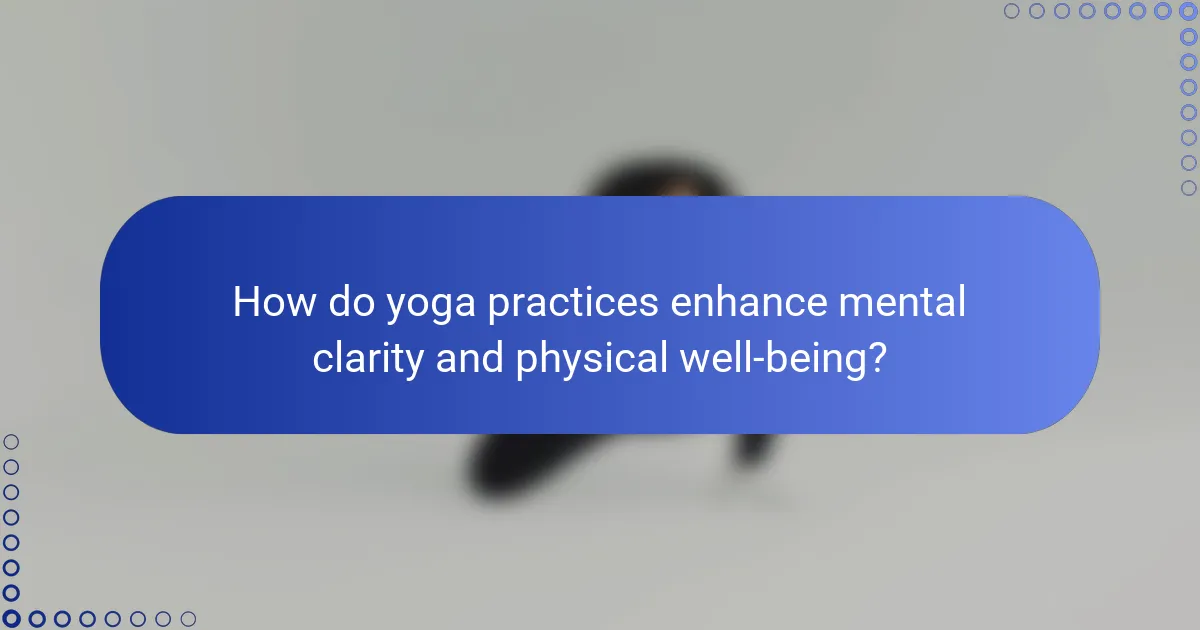
How do yoga practices enhance mental clarity and physical well-being?
Yoga practices significantly enhance mental clarity and physical well-being through mindfulness, breath control, and physical postures. Mindfulness in yoga promotes present-moment awareness, reducing stress and anxiety. Breath control techniques, or pranayama, improve oxygen flow and enhance focus. Physical postures, or asanas, strengthen the body, increase flexibility, and promote overall health. Studies indicate that regular yoga practice can lead to improved cognitive function and emotional regulation. Engaging in yoga fosters a holistic approach to well-being by integrating body and mind.
What are the physiological benefits of yoga for mental clarity?
Yoga enhances mental clarity through improved focus, reduced stress, and increased mindfulness. Regular practice promotes neuroplasticity, allowing the brain to adapt and grow. As a result, individuals often experience heightened concentration and cognitive function. Additionally, specific poses and breathing techniques can stimulate brain activity, further supporting mental clarity. Research indicates that yoga can decrease anxiety levels, which contributes to a clearer mind and better decision-making skills.
Which yoga styles are most effective for improving focus and concentration?
Hatha, Vinyasa, and Kundalini yoga styles are most effective for improving focus and concentration. Hatha yoga emphasizes alignment and breath, promoting mindfulness. Vinyasa connects movement with breath, enhancing mental clarity. Kundalini incorporates breath control and meditation, fostering deep concentration. Each style offers unique benefits, supporting mental and physical well-being.
How does regular yoga practice impact stress levels and anxiety?
Regular yoga practice significantly lowers stress levels and anxiety. The combination of physical postures, breathing techniques, and mindfulness fosters relaxation and mental clarity. Studies show that consistent yoga can reduce cortisol levels, the body’s primary stress hormone, leading to improved emotional well-being. Additionally, yoga enhances self-awareness, allowing practitioners to manage anxiety more effectively. This holistic approach not only promotes physical health but also cultivates a resilient mindset, making it a powerful tool for mental health management.
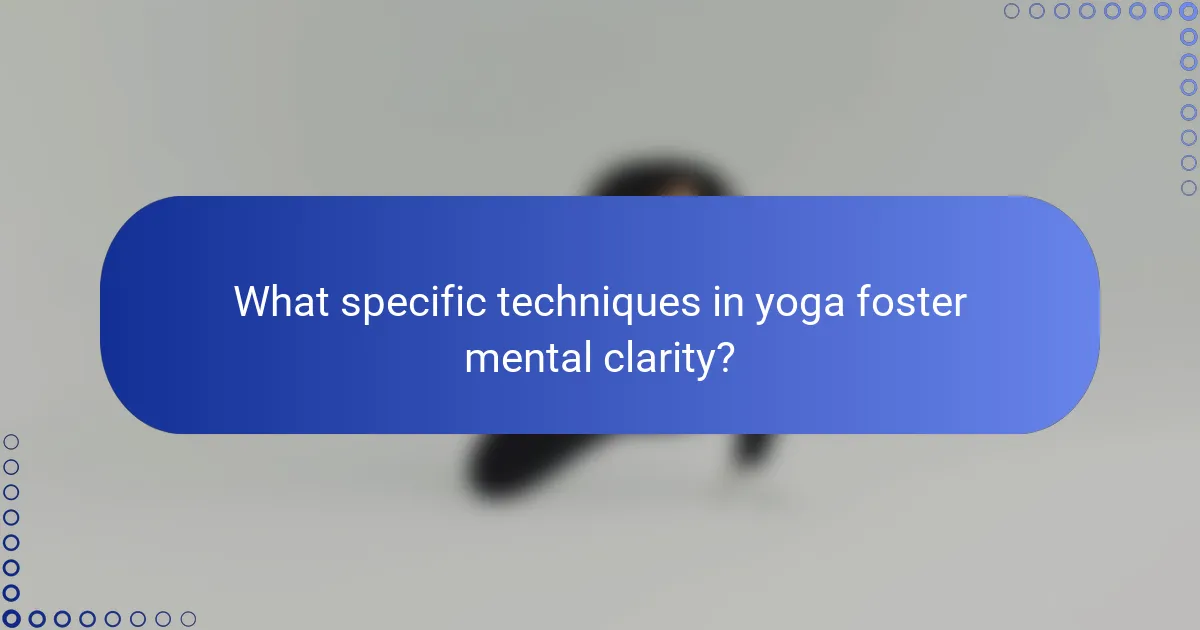
What specific techniques in yoga foster mental clarity?
Yoga techniques that enhance mental clarity include mindfulness meditation, pranayama (breath control), and specific asanas like downward dog and tree pose. Mindfulness meditation sharpens focus and awareness. Pranayama regulates breath, calming the mind and reducing anxiety. Asanas improve circulation and stimulate brain function. These practices collectively foster a serene mental state, promoting clarity and concentration.
How do mindfulness and meditation integrate with yoga for cognitive benefits?
Mindfulness and meditation enhance yoga’s cognitive benefits by promoting focus and reducing stress. Integrating these practices improves mental clarity and emotional resilience. Research indicates that regular engagement in mindfulness techniques can enhance cognitive flexibility and attention. Moreover, the combination of yoga postures with mindful breathing fosters a deeper mind-body connection, leading to improved overall well-being. This holistic approach not only supports mental health but also contributes to physical vitality, making it a powerful practice for those seeking comprehensive cognitive enhancement.
What role does breath control play in enhancing mental focus during yoga?
Breath control significantly enhances mental focus during yoga by promoting relaxation and clarity. It helps practitioners achieve a meditative state, reducing distractions and improving concentration. Controlled breathing techniques, such as pranayama, increase oxygen flow, which can enhance cognitive function and mental acuity. As a result, individuals experience improved mindfulness and presence during their practice, fostering both mental clarity and physical well-being.
Which poses are particularly beneficial for mental clarity?
Certain yoga poses enhance mental clarity effectively. Poses like Downward Dog, Tree Pose, and Child’s Pose promote focus and reduce stress. These asanas improve blood flow to the brain, facilitating better concentration. Additionally, seated poses such as Sukhasana and Padmasana support mindfulness, fostering a calm and clear mind.
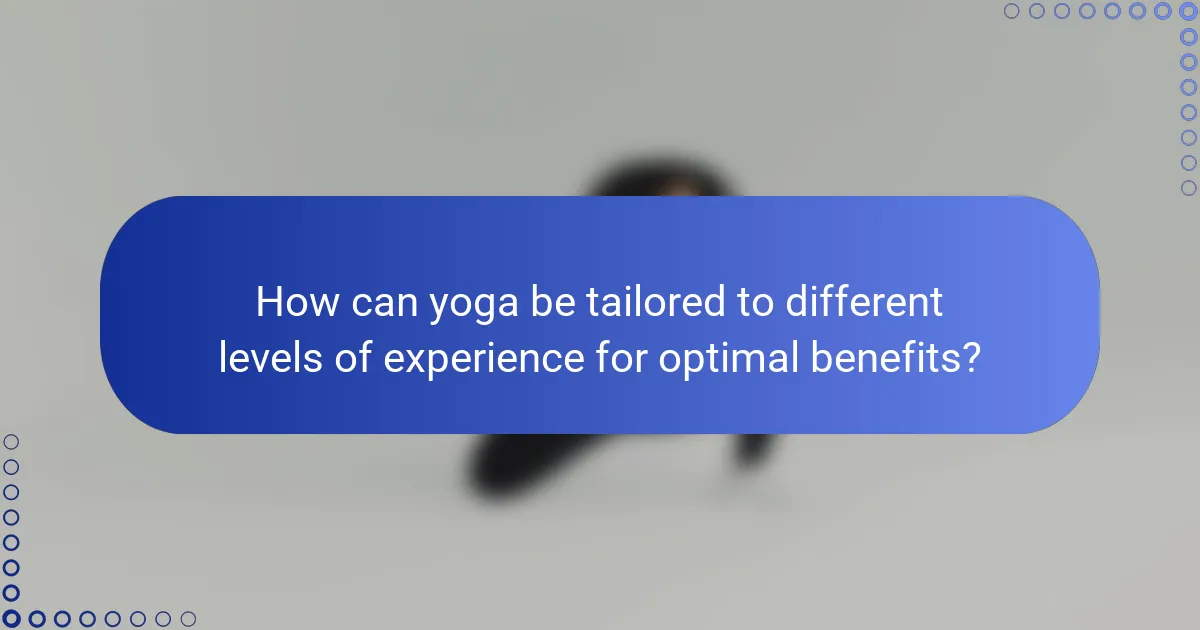
How can yoga be tailored to different levels of experience for optimal benefits?
Yoga can be tailored to different experience levels through modifications and variations, ensuring optimal benefits for each practitioner. Beginners can focus on foundational poses to build strength and flexibility, while intermediate and advanced practitioners can incorporate more complex asanas and breathing techniques for deeper mental clarity and physical well-being.
For beginners, gentle classes emphasize alignment and basic postures. Intermediate levels introduce dynamic flows and balance challenges. Advanced sessions often include intricate sequences and meditation practices. This tiered approach allows each level to experience yoga’s mental and physical benefits effectively.
Adjustments in class intensity, duration, and focus on mindfulness enhance the practice for all levels. Tailoring yoga in this way supports individual growth and fosters a deeper connection to the practice.
What beginner-friendly yoga practices can enhance mental clarity?
Beginner-friendly yoga practices that enhance mental clarity include simple techniques like mindfulness meditation, breath awareness, and gentle poses. These practices promote relaxation and focus, helping to clear the mind.
1. Mindfulness Meditation: Focus on your breath for 5-10 minutes. This practice enhances awareness and reduces stress.
2. Breath Awareness: Practice deep breathing exercises. This technique calms the nervous system and improves concentration.
3. Gentle Poses: Incorporate poses like Child’s Pose and Corpse Pose. These positions promote relaxation and mental stillness.
4. Sun Salutations: Perform a few rounds to energize the body and clear mental fog. This sequence connects movement with breath, enhancing clarity.
These practices can be easily integrated into daily routines, promoting both mental clarity and physical well-being.
How can experienced practitioners deepen their practice for greater mental and physical benefits?
Experienced practitioners can deepen their yoga practice by incorporating advanced techniques and mindfulness strategies. These approaches enhance mental clarity and physical well-being.
Integrating pranayama, or breath control, can significantly improve focus and reduce stress. Practicing meditation alongside asanas fosters a deeper connection between mind and body. Additionally, exploring different yoga styles, such as Kundalini or Yin, offers unique benefits that may enhance overall practice.
Regularly attending workshops or retreats can provide fresh insights and techniques. Engaging with a community of like-minded individuals encourages accountability and support, further enriching the practice.
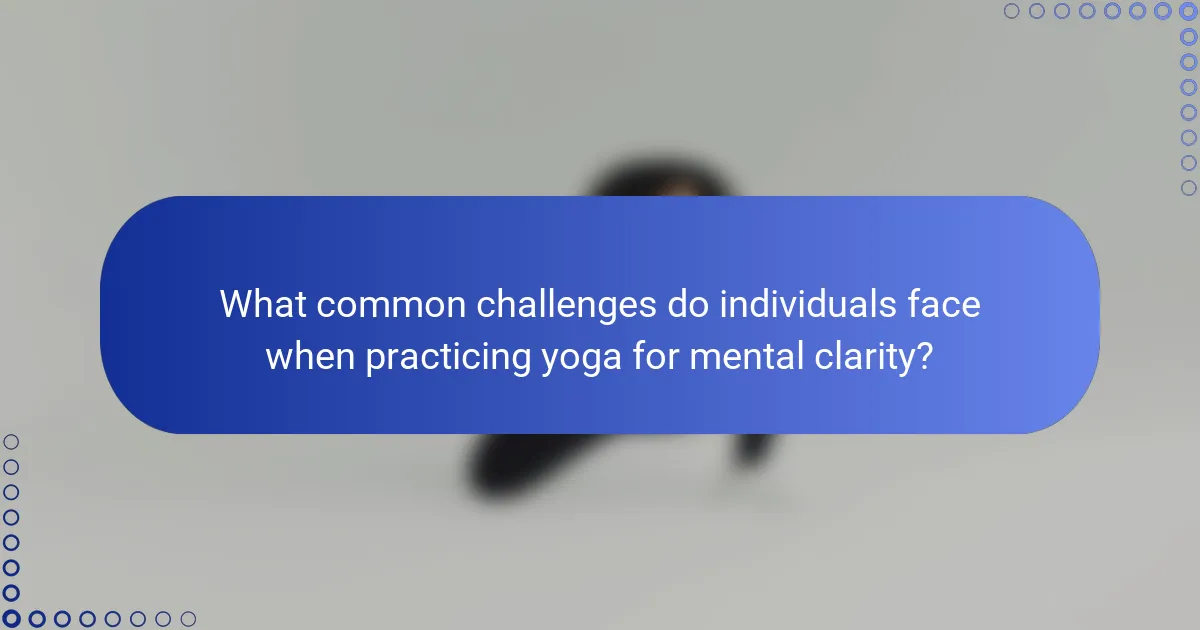
What common challenges do individuals face when practicing yoga for mental clarity?
Individuals often face challenges such as distractions, physical discomfort, and mental resistance when practicing yoga for mental clarity. Distractions can arise from external noise or internal thoughts, making it difficult to focus. Physical discomfort may stem from tight muscles or improper alignment, hindering relaxation. Mental resistance includes self-doubt or frustration with progress, which can disrupt the flow of practice. Developing strategies to overcome these obstacles can enhance the benefits of yoga for mental clarity.
How can distractions be minimized during yoga sessions?
Minimizing distractions during yoga sessions can be achieved through several effective strategies. Create a dedicated space for practice, free from interruptions. Use calming music or nature sounds to enhance focus. Establish a routine to signal the mind and body that it’s time for yoga. Limit digital device usage to avoid notifications. Practicing mindfulness techniques can also help maintain concentration throughout the session.
What are the most frequent misconceptions about yoga and mental clarity?
Many misconceptions exist about yoga’s impact on mental clarity. A common belief is that yoga is only physical exercise, neglecting its mental benefits. In reality, yoga practices enhance focus and reduce stress through mindfulness and breath control. Another misconception is that yoga is only for flexible individuals, while it can be adapted for all body types. Additionally, some think yoga requires extensive time commitments, but even short sessions can improve mental clarity. Lastly, many believe yoga is solely about relaxation, overlooking its potential to energize and enhance cognitive function.
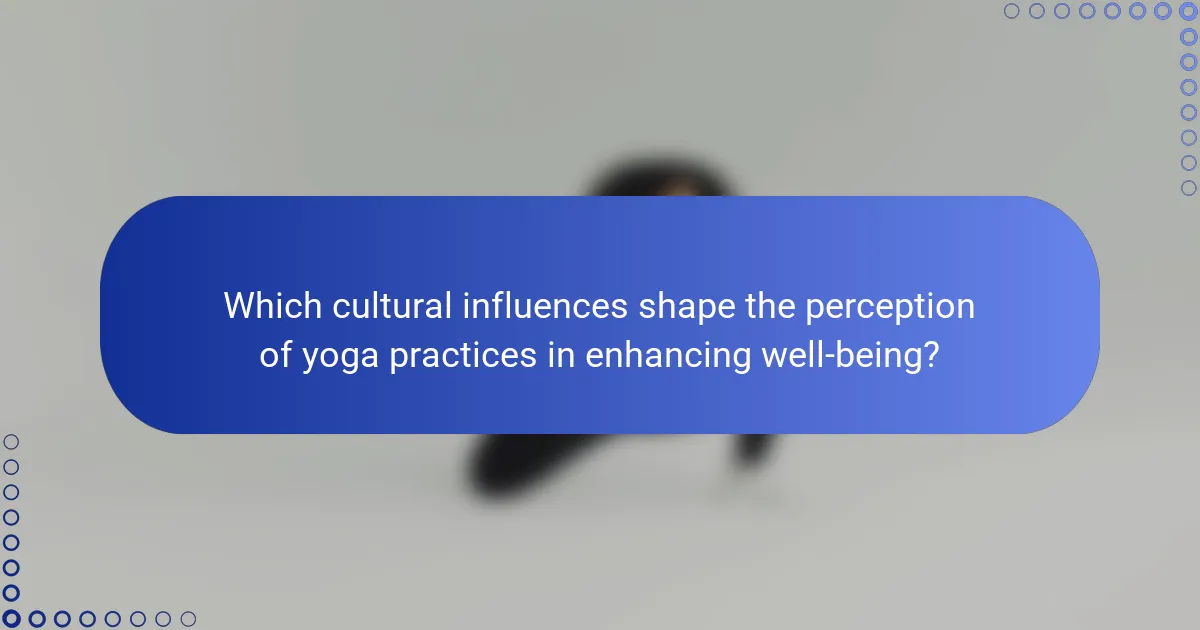
Which cultural influences shape the perception of yoga practices in enhancing well-being?
Cultural influences significantly shape perceptions of yoga practices in enhancing well-being. Different cultures emphasize various aspects of yoga, such as mindfulness, physical fitness, or spiritual growth. For instance, Western cultures often focus on yoga’s physical benefits, promoting stress relief and improved flexibility. In contrast, Eastern cultures may highlight the spiritual and meditative elements, fostering mental clarity and inner peace. This diversity in focus affects how individuals approach yoga, tailoring practices to align with personal and cultural values. Additionally, the integration of yoga into wellness programs reflects a growing recognition of its holistic benefits across cultures.
How do regional practices differ in their approach to yoga and mental clarity?
Regional practices vary significantly in their approach to yoga and mental clarity. Different cultures emphasize unique techniques and philosophies that enhance mental focus and physical well-being.
In India, traditional yoga practices often integrate meditation and breathing exercises, fostering deep mental clarity. Techniques like Pranayama focus on breath control, which is believed to clear the mind and enhance concentration.
In contrast, Western yoga styles frequently emphasize physical postures and fitness. Practices such as Vinyasa or Power Yoga prioritize strength and flexibility, sometimes at the expense of meditative elements. This can lead to improved physical health but may not fully address mental clarity.
Additionally, some regions incorporate local spiritual beliefs into their yoga practices. For example, Tibetan yoga combines physical postures with Buddhist meditation techniques, aiming for a holistic approach to mental clarity and spiritual growth.
Overall, while the core principles of yoga remain consistent, regional adaptations create diverse pathways to achieving mental clarity and physical well-being.
What unique attributes of yoga in various cultures contribute to its effectiveness?
Unique attributes of yoga in various cultures enhance its effectiveness through diverse practices and philosophies. For instance, Indian yoga emphasizes spiritual growth, while Tibetan yoga incorporates visualization techniques. African traditions may focus on community and rhythm, promoting mental clarity through collective movement. Japanese yoga often integrates mindfulness and breathing, fostering deep relaxation. Each cultural approach contributes unique elements that enhance both mental clarity and physical well-being.
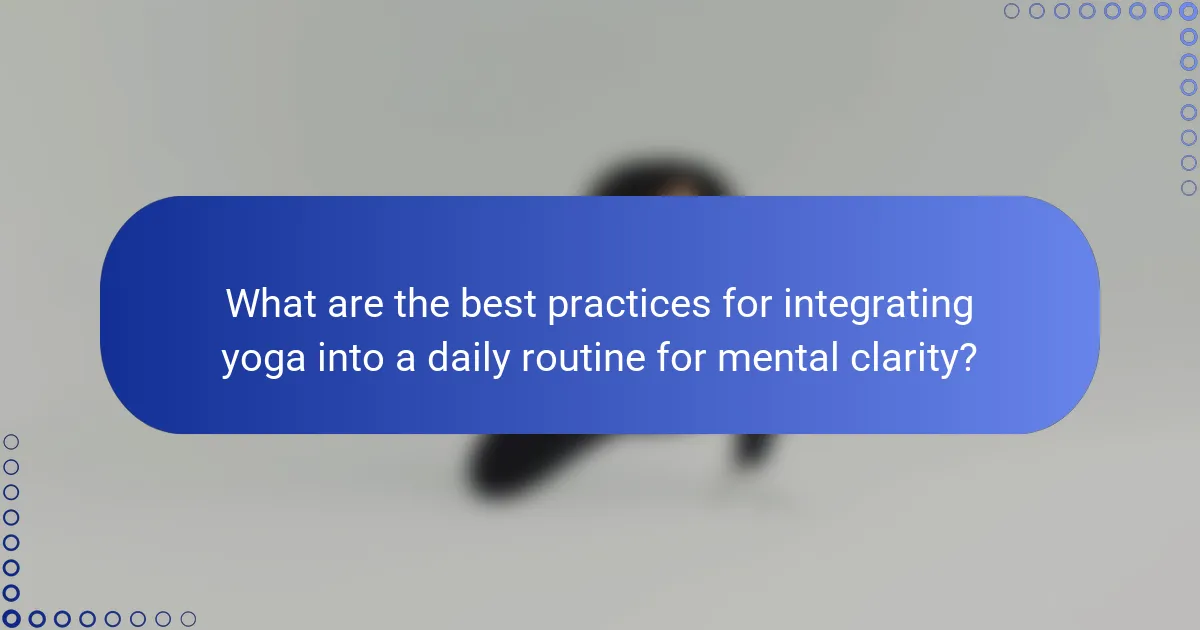
What are the best practices for integrating yoga into a daily routine for mental clarity?
Integrating yoga into a daily routine enhances mental clarity through consistent practice. Start with a morning session, focusing on mindfulness and breath control to set a positive tone for the day.
1. Choose a specific time each day to practice, such as early morning or before bed.
2. Incorporate various styles like Hatha for relaxation or Vinyasa for energy.
3. Use guided sessions or apps to maintain focus and structure.
4. Combine yoga with meditation to deepen mental clarity.
5. Maintain a journal to track progress and reflect on mental changes.
Regular practice can lead to improved concentration and reduced stress, fostering overall well-being.
How can individuals set realistic goals for their yoga practice?
Individuals can set realistic goals for their yoga practice by focusing on achievable outcomes. Start by assessing your current physical and mental state to establish a baseline. Set specific, measurable, and time-bound goals, such as practicing yoga three times a week for 30 minutes. Track your progress to maintain motivation and adjust goals as needed. Incorporate mindfulness to enhance mental clarity and physical awareness during practice, ensuring that goals align with personal values and lifestyle.
What expert tips can enhance the effectiveness of yoga for mental clarity?
Practicing yoga mindfully can significantly enhance mental clarity. Focus on breath control, meditation, and specific poses to stimulate cognitive function.
1. Prioritize breathwork to reduce stress and improve focus.
2. Incorporate meditation to cultivate mindfulness and clarity.
3. Engage in poses like Tree Pose and Eagle Pose to enhance concentration.
4. Maintain a consistent practice schedule for optimal results.
What common mistakes should be avoided when practicing yoga for well-being?
Avoiding common mistakes in yoga practice enhances both mental clarity and physical well-being. Key errors include neglecting proper alignment, skipping warm-ups, and pushing too hard into poses.
1. Ignoring Alignment: Proper alignment prevents injuries and maximizes benefits.
2. Skipping Warm-Ups: Warm-ups prepare the body, reducing the risk of strain.
3. Overexertion: Pushing beyond limits can lead to burnout and discouragement.
4. Inconsistent Practice: Regular practice builds progress and strengthens mental focus.
5. Disregarding Breath: Breath control enhances relaxation and improves concentration.
6. Comparing to Others: Focusing on personal progress fosters a positive mindset.
By addressing these mistakes, practitioners can optimize their yoga experience for enhanced well-being.